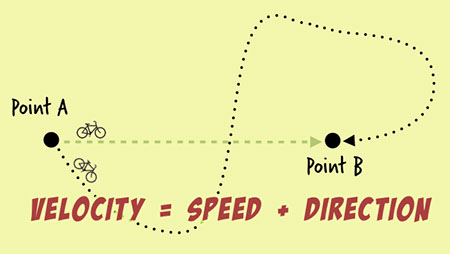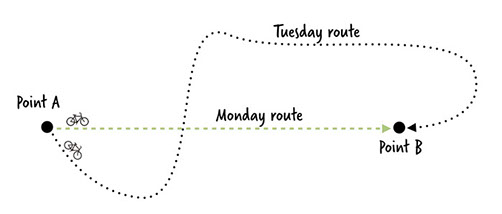SciGen Teacher Dashboard
Unit E1
Potential and Kinetic Energy
 Lesson: Speed vs. Velocity
Lesson: Speed vs. Velocity
Duration: Approximately 40 minutes
Students consider the difference between speed and velocity.
LEARNING OBJECTIVES
Students differentiate between velocity and speed.
Teacher Tips
- Speed and velocity are often used as synonyms. The distinction between the two is critical for high school physics, but less so for middle school students.
Teacher Tune-up
Teaching Notes
ACTIVITY OVERVIEW
- Consider the definitions (10 minutes)
- A weird example (15 minutes)
- Try it (15 minutes)
Consider the definitions (10 minutes)
Speed is a type of rate that measures how long it takes to travel a distance.
Velocity measures how fast something is moving plus the direction that the object is moving. So a car driving from Baltimore, Maryland, to Norfolk, Virginia, might have a velocity of 70 miles per hour south.
Are these definitions helpful?
- Sort of.
- Not really.
- Seriously?
A weird example (15 minutes)
If students have difficulty answering the question in the slide, consider discussing an additional situation where 1 student rides a bike around 3 sides of a square city block. Draw a sketch showing the path as she first rides north, then east, then south. If each side of the block is 50 yards long and she takes 20 seconds to ride each side, her total speed is 150 yards in 60 seconds. Compare this to a second student who walks east from the starting point and takes 60 seconds. His speed is 50 yards in 60 seconds.
Then retrace the routes and discuss the velocity. Point out that, for the first student, the velocity when traveling north and south add up to zero, because north and south are in opposite directions. So for the first student, the total, or average velocity, is 50 yards in 60 seconds, east. Because the second student travels in a straight line, his total velocity also equals 50 yards in 60 seconds, east.
On Monday, you rode your bike on the direct road from point A to point B in exactly one hour without stopping.
On Tuesday, you rode your bike on the curvy road from point A to point B in exactly one hour without stopping.
Did you ride your bike at a greater average speed on one of the roads?
(Absolutely!! The curvy one!)

Here's the weird part though:
Your overall (or average) velocity on Monday and Tuesday is the same. But how can that be? It’s because you measure average velocity using only the start and end points and by referring to direction. So if Point B is 15 miles east of point Point A, that means that your average velocity was 15 miles per hour east.
Try it (15 minutes)
Here’s another problem to think about:
On Wednesday, you rode your bike at 15 miles per hour from Point A to Point Y. On Thursday you rode your bike at 15 miles per hour from Point A to Point Z. That means that you traveled at the same speed on both Wednesday and Thursday. Right? Right.
But in this case, the average velocity is not the same.
TURN AND TALK: Why is the average velocity different?

The final Turn and Talk also contrasts speed versus velocity. Here, the directions to point Y and Z differ, so while the distances and time (thus the speed) are the same, the velocity is different.
BETA Version - Please send comments and corrections to info@serpinstitute.org